South West Coast Path diary
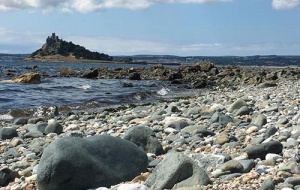 Brewster Scholarship 2018 Travel Diary – Christopher Chew
Brewster Scholarship 2018 Travel Diary – Christopher Chew
As a keen hiker, I was fortunate to win a Brewster Travel Scholarship this year which enabled me to walk part of the South West Coast Path in Cornwall from Falmouth to Land’s End. This week-long trip was also a welcome break from writing my MSc dissertation.
Despite having previously lived in the UK for over eight years, I had not made it to Cornwall and was extremely interested to visit this unique corner of the UK. In addition, a visit to the Eden Project had been on my to-do list for the last ten or so years, so this was a welcome opportunity to cross that item off the list.
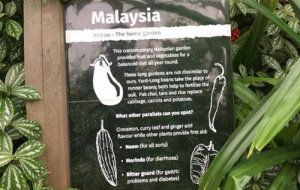
A little bit of Malaysia at the Eden Project.
Day 1 – Oxford to Charlestown (via St Austell and the Eden Project).
I caught an early morning train from Paddington to St Austell from where I would take a bus to the Eden Project. It so happened that a research supervisor from my medical school days was taking the same train to Plymouth and invited me into First Class with him and his fianceé. We spent the journey catching up on the ten years since we last worked together back in Peru – time well-spent. After I got into St Austell – which is a lovely little town – I had a quick breakfast and an equally quick look round before hopping on the bus. The Eden Project was impressive; two huge biomes of flora and fauna recreating the tropical and temperate zones of the world constructed on the site of an old China clay pit. Being Malaysian-Australian, I was particularly delighted by the Southeast Asian rainforest canopy walk (suitably humid too, just like the real thing) as well as the Western Australian garden. The free guided walks were comprehensive and informative, and thankfully the food court was conveniently located between the biomes, so I had a much-needed baobab and coconut flavoured ice cream after the canopy walk.
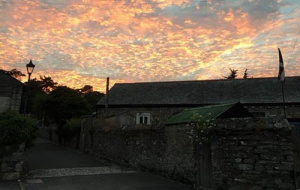
A blaze of gold and orange over Charlestown.
Accommodation tonight was in an AirBnB in Charlestown, a village with a Georgian harbour just outside St Austell. It turned out that I had arrived during regatta week and the village was buzzing. Nonetheless that did not spoil the beauty of the harbour or the sunset, and I got to see a couple of the tall ships that call Charlestown harbour home.
I am told the harbour is often used in period films, as are the tall ships. Dinner was at a local restaurant where I had my first taste of fresh Cornish seafood with a bellini – a fitting end to a great day.
Day 2 – Falmouth to Porthallow.
Weather: Fine; distance: 20 miles.
The next day I boarded a train to Falmouth, where I was to begin my walk. Perhaps a sign of how far the food scene and tourism have grown in Cornwall was the presence of a Rick Stein restaurant at the waterfront, along with hordes of visitors strolling the narrow streets. The establishment of a university campus also added to the liveliness of Falmouth, as there was a clear student vibe to the town. I started my walk after stocking up on the nexessary supplies like sunscreen and a wide-brimmed hat (we are well-trained to beware the effects of UV radiation in Australia) just before the Queen Mary Gardens, which were in full bloom. It was a warm sunny day, so everything was looking good for the 77-mile hike. The path hugged the coastline and I was awed by the crystal-clear blue water once away from the tourist beaches – it was not something I expected to see in England, even though this part of the country is known as the Riviera.
The destination for tonight was Porthallow, a cosy little village around a hill. I passed through a number of other villages, all beautiful: Helford, Mawnan, St Anthony-in-Meneage. Part of the hike involved a river crossing, which was a nice little break from walking. At Porthallow, the mid-point of the Southwest Coast path, I had dinner in a pub then a good, restful sleep at a family-run BnB. Tomorrow would be another long day of walking.
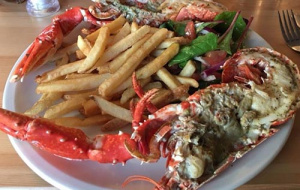
Possibly the best dinner in Cornwall!
Day 3 – Porthallow to The Lizard.
Weather: Fine; distance: 13.6 miles.
What a superb day this was. I had purposely selected this section of the path because I wanted to see the Lizard Peninsula (from Cornish An Lysardh, ‘The High Court’ – nothing to do with reptiles) in all its rugged glory, and it did not disappoint. The peninsula is remote and the terrain rather harsh, but the solitude and fresh air was what I needed after a hectic year at Oxford. I walked on clifftops, through fields and flowers, and some lonely fishing villages until I reached Coverack where I had lunch (seafood soup, naturally) at a café founded by the Roskillies of ice cream fame. There I noticed an odd hole in the floor above the kitchen, which the staff told me had to be made specially to let the flood waters out when the village experienced some rather disastrous flooding a few years ago! It would have been great if I could have spent some time wandering the town, but I wanted to get to the principal town of Lizard and have a swim before it got too late (I woke up a little later than I had planned, and the breakfast at the BnB was so good I ate more than I should). The swim, or rather a prolonged dip, in a hidden-away rocky cove was very refreshing – despite the heat of summer, the water was freezing cold. That night I had the best dinner of the entire trip at the Witch Ball pub, a whole Cadgwith lobster, freshly-caught the same day, with all the trimmings. And for only £24.95!
Day 4 – The Lizard to Porthleven.
Weather: Fine; distance: 15 miles.
This was another of my favourite days on the hike. The first order of business was to visit the lighthouse not far from Lizard Point, the southernmost tip of Britain. The light from this lighthouse was often the first light seen by those returning by sea to England, and it was only in 1988 that the lighthouse became automated. That’s 137 years of having a lighthouse-keeper at this rather desolate location! At Poldhu I came across an unexpected finding – a monument to Marconi, the inventor of the radio. This was to mark the first trans-oceanic telegraphic transmission to Glance Bay in Canada. Very random.
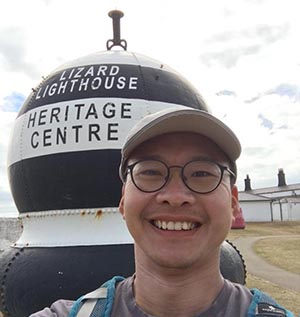
At the Lizard Point lighthouse.
The scenery on the walk today was spectacular. With so few people on the path, I had a lot of time to soak in the natural beauty and think. Every so often I’d come across a feature of interest, whether that be a field of wildflowers or a little church like St Winwaloe’s, the Church of the Storms. But the most wonderful thing I experienced today was Loe Bar, a spit of sandy land separating the sea to my left and a freshwater lake to my right, on the approach to Porthleven. At Porthleven I saw another glorious Cornish sunset on the (very picturesque) harbour before a delicious meal of Goan fish curry and warm sticky ginger pudding with toffee sauce at The Square. This is one thing I love about Cornwall – fresh seadfood at reasonable prices. Accommodation tonight was at Old Church Cottage, an AirBnB run by an elderly couple, Dick and Ruth. Dick used to work in the education field at Oxford and we had a nice chat over a couple of cups of tea about how Oxford has changed since he retired.
Day 5 – Porthleven to Penzance (with a detour to St Michael’s Mount).
Weather: Fine; distance: 13 miles.
I had an excellent rest at Old Church Cottage and Dick even cooked me a full English breakfast before I set off on the penultimate day of my hike. I wish I could have spent another day in Porthleven – even though it was a larger-sized village with its fair share of visitors, it had an air of tranquillity about it and an art scene I would have loved to explore. But onwards and upwards – there were kilometres to cover and places to see. This part of the coast was dotted with tin mines, and mine shafts sitting pretilly among wildflowers were frequently encountered. At Praa Sands I stopped at a beachside café to have elevenses – cream tea and scones with jam and Cornish clotted cream (jam before the cream, of course – when in Cornwall, do as the Cornish do; even Her Majesty herself says this is the proper way, I’m told). After Praa Sands came Prussia Cove, where the smuggler John Carter operated – just one of many smugglers’ coves in Cornwall. It was easy to see why – the coves are secluded and difficult to get to, with caves aplenty to stash goods.

St Michael’s Mount from Perranuthnoe.
But the star of today was St Michael’s Mount, a replica of Mont St Michel in Normandy, France on a small tidal island linked to the mainland by a causeway and built by the same order of monks. It is now in lay hands, and the current owners Lord and Lady St Levan still live in the castle. Exploring the castle, learning about its history, and walking the grounds (Cornish pasty in hand) was fascinating, but soon it was time to take the ferry back to Marazion on the mainland and continue on to Penzance, the final stop for today. I did not know much about Penzance (apart from the Pirates of Gilbert and Sullivan fame), but found it a rather nondescript town with some interesting buildings on historic Chapel Street, such as the Admiral Benbow pub (the one in Robert Louis Stevenson’s ‘Treasure Island’), the Union Hotel (where Lord Nelson’s death at Trafalgar was announced), and, across from the hotel, the Egyptian House (a house with a rather garish faux-Egyptian façade). I had forgotten to pre-book accommodation for tonight, so it was a scramble ringing around various establishments until I found myself a room above a pub, how old-school!
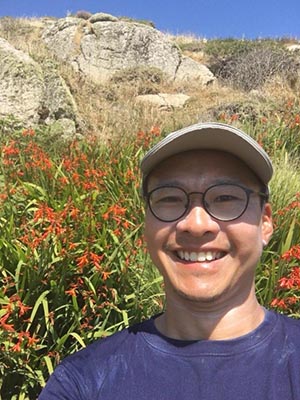
Wildflowers were plentiful on the hike.
Day 6 – Penzance to Land’s End.
Weather: Fine; distance: 15.2 miles.
Having fortified myself with a good breakfast from Duke Street Café (a café with proper coffee – the type of place that is not uncommon in Australian cities but rare in Britain!) I set out on the last leg of the path. The first settlement on the route was Newlyn, a working fishing village with some good seafood restaurants and pubs, then Mousehole (pronounced ‘mouzel’, but still one of the cutest placenames I have ever encountered). All the way to Lamorna Cove the path was mainly tarmac, but from Lamorna onwards took on a more rugged nature. In fact the part of the path through St Loy involved scrambling over rocks and pebbles on the beach, though there was some respite at Porthcurno, with its sandy, touristy beach and Penberth Cove which, like Newlyn, remains a working fishing harbour though on a much smaller, quainter scale. The approach to Land’s End was relatively flat and I could see the Land’s End complex an hour or so before actually reaching. The headland and surroundings reminded me of the physical geography lessons I had during high school, with sea arches and various other formations whose names I have long forgotten.
And then finally, after five days and 120 km of walking, I was there – Land’s End, the most southwesterly point of Britain! I would love to say that visiting the complex was a climactic experience, but I was sorely disappointed to find… a shopping mall and busloads of foreign tourists (I am told it is the same at John O’Groats, as both sites are owned by the same company). But for me, it was the journey, and not the destination, that mattered. I managed to do a long-distance walk, something I love, and see a most beautiful part of the UK in the process.
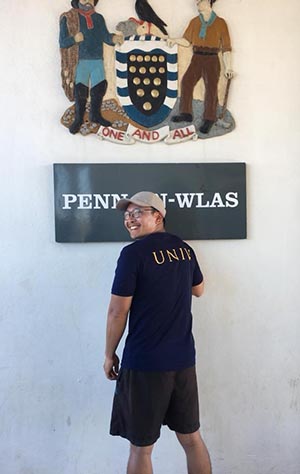 Day 7 – Penzance to Exeter.
Day 7 – Penzance to Exeter.
I took the bus back to Penzance from Land’s End and spent a night at a room above a pub (alternative accommodation was hard to find that night) before catching the train to Exeter and its cathedral, which I had always wanted to visit. A bonus was catching up with an English friend whom I had worked with in Cairns, Queensland but had not seen since her return to the UK in 2012. Exeter was a lovely city with much of its historic architecture and sites, even in the inner city, so well-preserved. The cathedral, founded in 1112 (even older than Univ!) was a stunning example of Gothic architecture with the longest uninterrupted ceiling vault in England, although I think that the chapel of Exeter College is still prettier. Unfortunately I was not able to go on a tour of the Underground Passages as they were booked up well in advance, but the visitors’ centre was highly informative, and I had a nice wander around the city centre before meeting my friend and spending the night at her house, following which I left to go back to Oxford the next day. How did a week fly by so quickly?
I would like to conclude with this photo, which I specially took at Land’s End to acknowledge Univ’s Brewster Travel Scholarship. Doing my Masters at Oxford was certainly an amazing year, made more so by the many benefits being at Oxford’s oldest (and, in my biased opinion, best) college confers, and for the privilege of being a Univite I am truly grateful.
Find out more about the range of travel grants and scholarships available to assist Univ students on our Travel Grants page or read further travel reports.
Published: 22 January 2019
Explore Univ on social media
